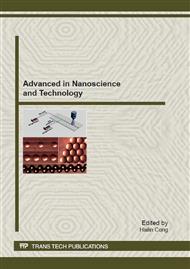[1]
D. S. Ginley and C. Bright, Transparent conducting oxides, MRS Bull, 25 (2000) 15-18.
DOI: 10.1557/mrs2000.256
Google Scholar
[2]
Hamberg and C. G. Granqvist, Evaporated Sn-doped In2O3 films: Basic optical properties and applications to energy-efficient windows, J. Appl. Phys. 60 (1986), R123-159.
DOI: 10.1063/1.337534
Google Scholar
[3]
Yutaka Furubayashi, Taro Hitosugi, Yukio Yamamoto, Kazuhisa Inaba, Go Kinoda, Yasushi Hirose, Toshihiro Shimada and Tetsuya Hasegawa, A transparent metal: Nb-doped anatase TiO2, Appl. Phys. Lett. 86 (2005) 252101.
DOI: 10.1063/1.1949728
Google Scholar
[4]
B. -S. Jeong, D.P. Norton and J.D. Budai, Conductivity in transparent anatase TiO2 films epitaxially grown by reactive sputtering deposition, Solid-State Electronics 47 (2003) 2275-2278.
DOI: 10.1016/s0038-1101(03)00210-7
Google Scholar
[5]
Xiao Wang Zheng, Zhi Qing Li, Low-temperture magnetoresistance of Nb-doped TiO2 transparent conducting films, Solid State Communications, 150 (2010), 1625-1628.
DOI: 10.1016/j.ssc.2010.06.040
Google Scholar
[6]
E. György, G. Socol, E. Axente, I.N. Mihailescu, C. Ducu and S. Ciuca, Anatase phase TiO2 thin films obtained by pulsed laser deposition for gas sensing applications, Appl. Surf. Sci. 247 (2005) 429-433.
DOI: 10.1016/j.apsusc.2005.01.074
Google Scholar
[7]
Y. Hatanaka, H. Naito, S. Itou and M. Kando, Photocatalytic characteristics of hydro-oxygenated amorphous titanium oxide films prepared using remote plasma enhanced chemical vapor deposition, Appl. Surf. Sci. 244 (2005), 554-557.
DOI: 10.1016/j.apsusc.2004.10.118
Google Scholar
[8]
Chun Wang, Jügen Meinhardt and Peer Löbmann, Growth mechanism of Nb-doped TiO2 sol–gel multilayer films characterized by SEM and focus/defocus TEM, J. Sol-Gel. Sci. Techn. 53 (2010), 148-153.
DOI: 10.1007/s10971-009-2070-7
Google Scholar
[9]
Liang Zhao, Xiaoru Zhao, Jinming Liu, An Zhang, Danhong Wang and Bingbo Wei, Fabrications of Nb-doped TiO2 (TNO) transparent conductive oxide polycrystalline films on glass substrates by sol–gel method, J. Sol-Gel, Sci. Techn. 53 (2010) 475-479.
DOI: 10.1007/s10971-009-2102-3
Google Scholar
[10]
M. D. McCluskey and S. J. Jokela, Defects in ZnO, J. Appl. Phys. 106 (2009) 071101.
Google Scholar
[11]
C. M. Yim, C. L. Pang, and G. Thornton, Oxygen vacancy origin of the surface band-gap state of TiO2(110) Phys. Rev. Lett. 104 (2010) 036806.
Google Scholar
[12]
Ulrike Diebold, Jeremiah Lehman, Talib Mahmoud, Markus Kuhn, Georg Leonardelli, Wilhelm Hebenstreit, Michael Schmid, Peter Varga, Intrinsic defects on a TiO2(110) (1×1) surface and their reaction with oxygen: a scanning tunneling microscopy study, Surf. Sci. 411 (1998).
DOI: 10.1016/s0039-6028(98)00356-2
Google Scholar
[13]
P. Galinetto, M.C. Mozzati, C. Vercesi, L. Malavasi, Y.A. Diaz Fernandez, F. Rossella, G. Drera, L. Sangaletti, Role of oxygen content on the magnetic properties of epitaxial anatase and rutile TiO2 thin films, Journal of Physics: Conference Series 200 (2010).
DOI: 10.1088/1742-6596/200/7/072030
Google Scholar
[14]
Gang Liu , José A. Rodriguez, Jan Hrbek, Brian T. Long, Donna A. Chen, Interaction of thiophene with stoichiometric and reduced rutile TiO2(1 1 0) surfaces: role of Ti3+ sites in desulfurization activity, J. Mol. Catal. A-Chem. 202 (2003) 215.
DOI: 10.1016/s1381-1169(03)00206-1
Google Scholar
[15]
G. S. Herman, Z. Dohna´lek, N. Ruzycki, and U. Diebold, G. S. Herman, Experimental investigation of the interaction of water and methanol with anatase-TiO2(101), J. Phys. Chem. B 107 (2003) 2788.
DOI: 10.1021/jp0275544
Google Scholar
[16]
Antonio Tilocca and Annabella Selloni, Reaction pathway and free energy barrier for defect-induced water dissociation on the (101) surface of TiO2-anatase, J. Chem. Phys. 119 (2003) 7445.
DOI: 10.1063/1.1607306
Google Scholar
[17]
Jinyu Zheng, Hua Yu, Xinjun Li and Shanqing Zhang, Enhanced photocatalytic activity of TiO2 nano-structured thin film with a silver hierarchical configuration, Appl. Surf. Sci. 254 (2008) 1630-1635.
DOI: 10.1016/j.apsusc.2007.07.165
Google Scholar
[18]
M. W. Zhu, J. Gong, C. Sun, J. H. Xia, and X. Jiang, Investigation of correlation between the microstructure and electrical properties of sol-gel derived ZnO based thin films, J. Appl. Phys. 104 (2008) 073113.
DOI: 10.1063/1.2993978
Google Scholar
[19]
Jia-Guo Yu, Huo-Gen Yu, Bei Cheng, Xiu-Jian Zhao, Jimmy C. Yu and Wing-Kei Ho, The Effect of Calcination Temperature on the Surface Microstructure and Photocatalytic Activity of TiO2 Thin Films Prepared by Liquid Phase Deposition, J. Phys. Chem. B 107 (2003).
DOI: 10.1021/jp036158y
Google Scholar
[20]
Liqiang Jing, Yichun Qu, Baiqi Wang, Shudan Li, Baojiang Jiang, Libin Yang, Wei Fu, Honggang Fu and Jiazhong Sun, Review of photoluminescence performance of nano-sized semiconductor materials and itsrelationships with photocatalytic activity, Solar Energy and Solar Cells, 90 (2006).
DOI: 10.1016/j.solmat.2005.11.007
Google Scholar
[21]
Diana Mardare, M. Taska, M. Delibas and G.I. Rusu, On the structural properties and optical transmittance of TiO2 r. f. sputtered thin films, Appl. Surf. Sci. 156 (2000) 200-206.
DOI: 10.1016/s0169-4332(99)00508-5
Google Scholar
[22]
Jaan Aarik, Aleks Aidla, Alma-Asta Kiisler, Teet Uustare and Väino Sammelselg, Effect of crystal structure on optical properties of TiO2 films grown by atomic layer deposition, Thin Solid Films 305 (1997) 270-273.
DOI: 10.1016/s0040-6090(97)00135-1
Google Scholar
[23]
T. Asanuma, T. Matsutani, C. Liu, T. Mihara and M. Kiuchi, Structural and optical properties of titanium dioxide films deposited by reactive magnetron sputtering in pure oxygen plasma, J. Appl. Phys. 95 (2004) 6011-6016.
DOI: 10.1063/1.1728313
Google Scholar
[24]
Hongzhi Cheng and Annabella Selloni, Surface and subsurface oxygen vacancies in anatase TiO2 and differences with rutile, Phys. Rev. B 79 (2009) 092101.
Google Scholar


